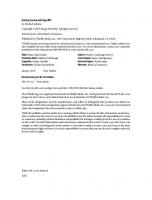Kefir: Getting Started Guide
https://www.culturedfoodlife.com/
426 79 2MB
English Pages [6]
Recommend Papers
File loading please wait...
Citation preview
www.CulturedFoodLife.com
Donna Schwenk
GETTING STARTED GUIDE
by Donna Schwenk
How it all started Desperately seeking answers to my health problems, one afternoon I stumbled into a health food store. I found a book called The Body Ecology Diet by Donna Gates. I picked up the book and it fell open to a page on kefir and an explanation of kefir’s benefits. I was intrigued. The next book on the shelf was Nourishing Traditions by Sally Fallon. When I opened that book, I just happened to turn right to another page on kefir. Just then, a store employee walked by. He stopped, turned to me, and said, “That is the most important book you will ever read; you should pay attention. It could change everything you thought you knew.” Then he just strolled away. I had never heard of kefir, and yet in a few minutes two separate books had opened to pages on it and a total stranger had told me to pay attention. Now I was paying attention. So I walked over to the dairy section, found the kefir, grabbed a bottle, and put it in my cart—along with those two books. Then, I checked out and headed home, quietly hoping that this was the answer to my prayers.
Kefir Getting Started Guide
Kefir was the first cultured food I made and mastered. It became my best friend and teacher as I learned all about these special foods. Kefir has been called the champagne of yogurt, but it’s so much more than that. Kefir contains 35-50 major strains of good bacteria not commonly found in yogurt. Kefir is a turbo-charged-energy-anti-biotic-colon-cleansing drink. Yogurt is a mild nutrient-rich drink that pre-digests the lactose helping the body better assimilate the good stuff. Kefir is much easier to make than yogurt and only requires a canning jar or vessel. Kefir can help you digest everything. Kefir’s active yeasts, good bacteria, and excess digestive enzymes provide more nutritive value than yogurt by helping digest the foods you eat. Constipation is a thing of the past. If you drink kefir at night, no acid reflux! Here are some more benefits: •
Eliminates constipation
•
Reduces or eliminates allergies
•
Reduces or eliminates asthma symptoms
•
Reduces or eliminates cold and flu illnesses
•
Helps to reduce or eliminate acne
•
Treats yeast infections
•
Promotes a natural “good” feeling
•
Effective as the strongest natural antibiotic without side effects
•
Replenishes the body with good bacteria after antibiotic use
•
Treats diarrhea
•
Aids lactose intolerance
•
Promotes deep sleep
•
Heals ulcers
1
www.CulturedFoodLife.com
Donna Schwenk
There are two ways that I teach people how to make kefir. You can either use Kefir Grains or Easy Kefir powder packets. Each method has its own advantages and disadvantages. When I first started making my own kefir, I used Kefir Powder Packets. I call this method “Kefir for Beginners.” It’s really easy and it doesn’t require you to make kefir every day. It comes in a powder form, and you basically just add milk and you’re done. Four packages can make up to 28 gallons of kefir. So if you’re struggling or feel overwhelmed, this is a great place to start. The disadvantage to this method is that eventually you will have to purchase more Easy Kefir packets.
I primarily make kefir using live Kefir Grains. It’s a little bit more involved, but still really easy. You have to keep your grains fed and happy, but in return they will make delicious kefir for you! The great thing is that you don’t need to purchase additional grains every so often as long as you take care of them. Your grains will actually grow in size and multiply every time you make kefir with them!
This is how I make kefir every day!
Easy Kefir is made from freeze-dried kefir grains that are ground up into a fine powder. I love Easy Kefir because not only does it contain the same 50+ good bacteria found in live kefir grains, but also because you can use Easy Kefir to make dairy-free kefir! I’ll show you the kefir grains method first.
Kefir Getting Started Guide
2
www.CulturedFoodLife.com
Donna Schwenk
How to make kefir using live kefir grains Ingredients •
2 Tablespoons Kefir Grains (If you live outside the USA, check out Kefirhood.com or TorontoAdvisors.com)
•
2
•
Strainer and spoon
•
2-3 cups fresh milk
Quart Jars with Lids
Most milk types are acceptable, including whole milk, fat-reduced, non-fat, pasteurized, and homogenized. I mostly enjoy fresh raw whole cow’s milk to culture Kefir. However, you should stay away from ultra-pasteurized milk when making kefir. Your kefir won’t do well. Many times organic milk that you purchase from a store is ultra-pasteurized, even if it doesn’t say so. So if you choose to use organic milk, make sure you know what you are getting and that it's not ultra-pasteurized.
Step 1 •
Place fresh kefir grains in a glass jar and fill with fresh milk. (leave some room at the top)
•
Place a lid or plastic wrap on the jar and let sit at room temperature (Preferably around 70°F) for approximately 24 hours or until the milk has thickened or become sour to your liking.
Step 2
Kefir Getting Started Guide
•
Pour the contents into a strainer and strain the kefir into your second jar to separate the grains from the liquid kefir.
•
What you’ve strained is kefir ready to drink, or you can put it in the fridge for later.
3
Donna Schwenk
www.CulturedFoodLife.com
Step 3 •
Place the kefir grains from the strainer back into the first jar and fill with fresh milk.
•
Place a lid or plastic wrap on the jar and let it ferment again. The process is simply repeated for the next batch!
Notes •
After your kefir has fermented, it might be thin and pourable or be thick like yogurt.
•
The temperature in your house determines how quickly it ferments.
•
In the summer it ferments faster and tends to be thinner. In the winter it ferments slower and is usually thicker and creamier.
•
If you go on vacation or simply need to take a break, place your grains in milk and put them in your refrigerator. They’ll slow down their production of making kefir and won’t need to be fed as often. Just don’t forget about them! One Tablespoon of grains to one cup of milk will last a week in your refrigerator before you need to change the milk. If you want to give your grains some extra food, I recommend adding the prebiotic Prebio Plus.
•
If your kefir separates into whey and curds, don’t worry! It’s just a little over fermented and is still good to drink. Next time, simply add more milk (or fewer grains) or shorten the fermenting time.
•
To make your separated kefir creamy, remove the grains and place the over-fermented kefir into a blender for a few seconds. Then pour the kefir into a jar and place it in your refrigerator for eight hours. I also highly recommend adding a prebiotic like Prebio Plus. It’s extra food for your kefir and I’ve found it to be the best way to help make your kefir super creamy again!
Kefir Separated into Curds & Whey
If you choose to adopt some kefir grains, you HAVE to take care of them. It really is like having a new pet. So if you travel a lot or lead a very busy life, that’s something you will have to keep in mind. Perhaps the Easy Kefir method may be the way to go. I really love my kefir grains, almost as much as I love my children. If you take care of your grains and love them half as much as I do, they will make you wonderful kefir for the rest of your life! Kefir Getting Started Guide
4
www.CulturedFoodLife.com
Donna Schwenk
How to make kefir using Easy Kefir Ingredients •
1 packet of Easy Kefir
•
4 cups fresh milk
•
1 Quart Jar with Lid
Most milk types are acceptable, including whole milk, fat-reduced, non-fat, pasteurized, and homogenized. I mostly enjoy fresh raw whole cow’s milk to culture Kefir. However, you should stay away from ultrapasteurized milk when making kefir. Your kefir won’t do well. Many times organic milk that your purchase from a store is ultra-pasteurized, even if it doesn’t say so. So if you choose to use organic milk, make sure you know what you are getting and that it's not ultrapasteurized.
Step 1 •
Pour four cups of milk into a quart-sized jar. The milk doesn’t need to be warm, it can be cold from the fridge.
Step 2 •
Kefir Getting Started Guide
Sprinkle the entire contents of one Easy Kefir packet into the jar and mix well.
5
Donna Schwenk
www.CulturedFoodLife.com
Step 3 •
Put a lid on the jar and set it on your counter at 72° to 75° F for 18 to 24 hours. If the temperature is below 72° let it ferment a little longer.
•
You will know it is ready when the milk has thickened and has a distinctive, sour fragrance. Final consistency is pourable and thicker like yogurt.
•
Place into the refrigerator. Even in your refrigerator the fermentation process continues, but chilling it will slow down the fermentation of the healthy bacteria and beneficial yeasts.
Re-culturing Your Kefir Once you’ve made your first batch (quart) of kefir, you can use some of it to make more kefir, so don’t drink all of it! Simply take a portion of this kefir, add it to new milk, and let it culture it again. You can do this up to seven times and in larger quantities, or perhaps more than seven times if you do it every day like I do. Just keep doing this until it stops re-culturing, then you'll know that you need to use another Easy Kefir packet. •
To make one quart: use 1/4 cup from the previous batch.
•
To make 1/2 gallon: use 1/2 cup from the previous batch.
•
To make one gallon: use 1 cup from the previous batch.
Do not use more than the recommended amount when re-culturing kefir. Bacteria like room to grow, and adding too much will make it culture faster, causing it to become more sour.
Once you are able to grasp the basics of this guide, I invite you to check out the information on my website. There is more that you can learn that will make your experiences with kefir even better! I have many articles on things like: •
How to Second Ferment Kefir. Not only does second fermenting kefir increase the nutrients, it makes it taste a LOT better!
•
Learn How to Make Kefir Cheese and Whey. They are used in a lot of delicious recipes!
•
Can't handle kefir made from dairy milk? Learn How to Make Dairy-Free Kefir!
I also have recipes, videos, and even a forum where you can ask questions. Check it out!
Warmly, Kefir Getting Started Guide
6










